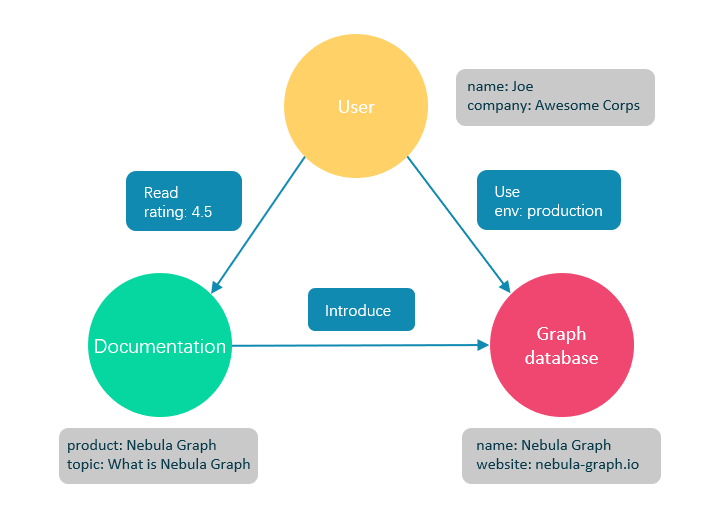What is NebulaGraph¶
NebulaGraph is an open-source, distributed, easily scalable, and native graph database. It is capable of hosting graphs with hundreds of billions of vertices and trillions of edges, and serving queries with millisecond-latency.

What is a graph database¶
A graph database, such as NebulaGraph, is a database that specializes in storing vast graph networks and retrieving information from them. It efficiently stores data as vertices (nodes) and edges (relationships) in labeled property graphs. Properties can be attached to both vertices and edges. Each vertex can have one or multiple tags (labels).

Graph databases are well suited for storing most kinds of data models abstracted from reality. Things are connected in almost all fields in the world. Modeling systems like relational databases extract the relationships between entities and squeeze them into table columns alone, with their types and properties stored in other columns or even other tables. This makes data management time-consuming and cost-ineffective.
NebulaGraph, as a typical native graph database, allows you to store the rich relationships as edges with edge types and properties directly attached to them.
Advantages of NebulaGraph¶
Open source¶
NebulaGraph is open under the Apache 2.0 License. More and more people such as database developers, data scientists, security experts, and algorithm engineers are participating in the designing and development of NebulaGraph. To join the opening of source code and ideas, surf the NebulaGraph GitHub page.
Outstanding performance¶
Written in C++ and born for graphs, NebulaGraph handles graph queries in milliseconds. Among most databases, NebulaGraph shows superior performance in providing graph data services. The larger the data size, the greater the superiority of NebulaGraph.For more information, see NebulaGraph benchmarking.
High scalability¶
NebulaGraph is designed in a shared-nothing architecture and supports scaling in and out without interrupting the database service.
Developer friendly¶
NebulaGraph supports clients in popular programming languages like Java, Python, C++, and Go, and more are under development. For more information, see NebulaGraph clients.
Reliable access control¶
NebulaGraph supports strict role-based access control and external authentication servers such as LDAP (Lightweight Directory Access Protocol) servers to enhance data security. For more information, see Authentication and authorization.
Diversified ecosystem¶
More and more native tools of NebulaGraph have been released, such as NebulaGraph Studio, NebulaGraph Console, and NebulaGraph Exchange. For more ecosystem tools, see Ecosystem tools overview.
Besides, NebulaGraph has the ability to be integrated with many cutting-edge technologies, such as Spark, Flink, and HBase, for the purpose of mutual strengthening in a world of increasing challenges and chances.
OpenCypher-compatible query language¶
The native NebulaGraph Query Language, also known as nGQL, is a declarative, openCypher-compatible textual query language. It is easy to understand and easy to use. For more information, see nGQL guide.
Future-oriented hardware with balanced reading and writing¶
Solid-state drives have extremely high performance and they are getting cheaper. NebulaGraph is a product based on SSD. Compared with products based on HDD and large memory, it is more suitable for future hardware trends and easier to achieve balanced reading and writing.
Easy data modeling and high flexibility¶
You can easily model the connected data into NebulaGraph for your business without forcing them into a structure such as a relational table, and properties can be added, updated, and deleted freely. For more information, see Data modeling.
High popularity¶
NebulaGraph is being used by tech leaders such as Tencent, Vivo, Meituan, and JD Digits. For more information, visit the NebulaGraph official website.
Use cases¶
NebulaGraph can be used to support various graph-based scenarios. To spare the time spent on pushing the kinds of data mentioned in this section into relational databases and on bothering with join queries, use NebulaGraph.
Fraud detection¶
Financial institutions have to traverse countless transactions to piece together potential crimes and understand how combinations of transactions and devices might be related to a single fraud scheme. This kind of scenario can be modeled in graphs, and with the help of NebulaGraph, fraud rings and other sophisticated scams can be easily detected.
Real-time recommendation¶
NebulaGraph offers the ability to instantly process the real-time information produced by a visitor and make accurate recommendations on articles, videos, products, and services.
Intelligent question-answer system¶
Natural languages can be transformed into knowledge graphs and stored in NebulaGraph. A question organized in a natural language can be resolved by a semantic parser in an intelligent question-answer system and re-organized. Then, possible answers to the question can be retrieved from the knowledge graph and provided to the one who asked the question.
Social networking¶
Information on people and their relationships is typical graph data. NebulaGraph can easily handle the social networking information of billions of people and trillions of relationships, and provide lightning-fast queries for friend recommendations and job promotions in the case of massive concurrency.